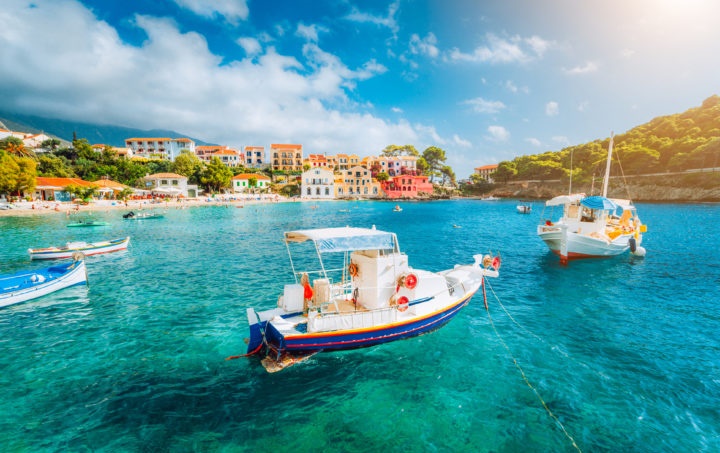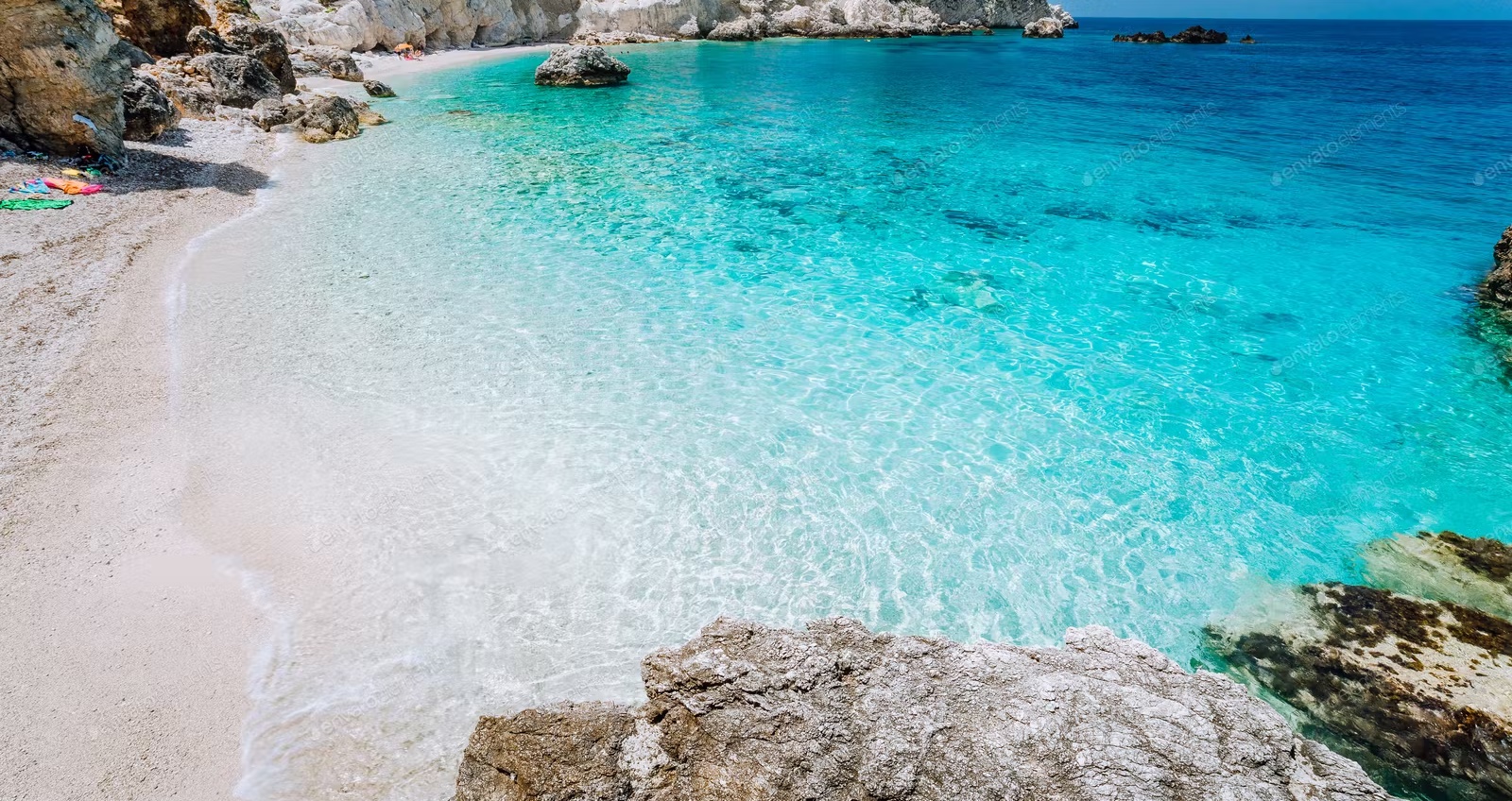
10 must-do things in Kefalonia
Crete, Corfu and Kos are known to most tourists when it comes to a holiday on the Greek islands, the island of Kefalonia is rather the exception and is therefore considered an insider tip among the Greek islands.
The largest of the Ionian Islands is less well known than other Greek islands in the Ionian Sea, such as Zakynthos or Corfu. Since 2018 there have been cheap direct flights from Germany to Kefalonia, so we present you with the most beautiful places, sights and beaches on Kefalonia that you definitely shouldn’t miss.
1. Visit Assos village
Because of the scenery, Assos is considered by many holidaymakers and locals to be the most beautiful place on Kefalonia. Assos is a picturesque village located in the northwest of the island. Anyone driving the main Kefalonian road from Argostoli to Fiskardo will be able to see Assos from afar from the road. Even from a distance, the idyllic scenery of the colorful houses surrounding a bay of crystal-clear water can be seen with the eye. The village was built on a narrow strip of land between the island and a peninsula. Amid pine and olive trees, Assos is watched over by a castle on the tip of the peninsula. This dates back to the 16th century when Kefalonia was still under Venetian rule.
2. Swim at Myrtos Beach
Kefalonia has dozens of beaches, but the most famous and beautiful beach in Kefalonia is Myrtos Beach. Barely 15 km from the village of Assos, the beach lies deep at the bottom of a dip. It is extremely rare that a beach of this length and size has almost no waves. You can imagine Myrtos Beach as a huge bay with still waters. Myrtos beach is popular due to its popularity, but thanks to its length of about 600 meters you can always find a quiet spot. Like many of the beaches in the Ionian Sea, Myrtos Beach consists mainly of white pebbles. However, if you prefer sand to pebbles, you should go to the right side of Myrtos Beach, which has fewer pebbles. As a “Blue Flag Beach”, Myrtos Beach is equipped with parking spaces, sanitary facilities, optional sunshades and loungers. Cafeteria and bars are also available, entrance fees are not charged.
3. Discover Kefalonia’s other beaches

In addition to the beach of Myrtos, there are of course also a variety of other beautiful beaches on Kefalonia. Best of all, they are all completely different from each other and that’s why it’s worth visiting several beaches. For fans of natural spectacles, there would be Xi Beach, for example, whose sand color is exceptionally orange and forms a strong contrast to the light green water. The more adventurous dare the 40-minute hike through the natural area of Oros Kasteli to the hidden Fteri Beach, which can otherwise only be visited by water. Agios Thomas Beach is well organized, has beach bars and even ladders that you can use to climb into the water from some spots, sort of like a pool! Finally, there is the beach of Poros, in the town of the same name, which offers an idyllic setting where the forest is reflected in the sea water.
4. Explore the Melissani Cave
Melissani Cave is one of the most famous sights and most beautiful natural wonders on Kefalonia. Melissani is an underground lake, about 36 m deep, surrounded by a stalactite cave. The grotto is said to have been the cult site of the shepherd god Pan in ancient times and is located about 6 kilometers from the port city of Sami. For €7 you can take a guided tour of the cave on a rowing boat. Since the lake is just 160 m long and 45 m wide, the tour only takes 15 to 20 minutes. The best time to take the boat tour is at 12 noon when the midday sun shines directly on the waters of Lake Melissani, which looks spectacular in photos. Unfortunately, the organizers also know this, because around noon rows of tour buses full of tourists appear. Therefore, it is best to be there before noon to avoid the whole thing.
5. Hiking in Mount Ainos National Park
Due to its nature, the soil of Kefalonia stores water longer in the top surface of the earth. Therefore Kefalonia is much greener than other Greek islands like Mykonos or Kos. This is particularly evident in Mount Ainos National Park, where the endemic black fir grows sluggishly around Mount Enos (Ainos). Hiking enthusiasts can climb the 1,628 meter high mountain via various hiking routes. It takes about 4 hours to reach the top of the mountain, so wear sturdy shoes for the hike. With a bit of luck you will encounter the unique wild horses of Kefalonia during the hike. These are not pure wild horses, but there are two theories about their origin. Domestic horses are said to have fled to the mountains after the Kefalonia earthquake in 1953, or they are horses that were released in times of war and have adapted to the wild over time.
6. Boat excursion to the neighboring island of Ithaki
Northeast of Kefalonia lies the smaller island of Ithaki, also known as Ithaca. Perhaps the name sounds familiar to you from the writings of the poet Homer as the home island of the hero Odysseus. In the central square of the main town of Ithaki, Vathi, there is even a bust of the Odyssey adventurer. The easiest way to get to Ithaki is from Kefalonia’s port town of Sami, where you can take day trips to Ithaki. You can simply moor in the main town of Vathi or hop from beach to beach, as some of the most beautiful beaches on the island can only be reached by water. Speaking of beaches, Kefalonians mainly visit Ithaki for the pristine beaches and tranquility, as there are not large tourist crowds here. Due to the elongated shape of the island, Ithaki has a multitude of small bays that you often have all to yourself and who doesn’t like a quasi-private beach surrounded by cypresses and silence?
7. Do Robola wine tasting and wine tour
Much like the Greek island of Santorini, Kefalonia produces its own local wine, Robola Kefallinias. This is a white wine made from the Robola grape variety. According to Greek mythology, the son of Hermes, the messenger of the gods, Kephalos, brought wine cultivation on behalf of the wine god Dionysus. According to history books, the type of wine can be explained by the Venetians, who introduced vines from what is now Italy around 400 years ago. The Robola grape variety no longer exists in Italy today, so the grape variety is considered native to Kefalonia. In addition to Robola, well-known varieties such as Moschofilero, Muscat and Mavrodaphne are also grown. The easiest way to taste all variants is during a wine tasting, which is offered by many wineries on Kefalonia on reservation. Depending on the season, the wine tasting includes a tour of the vineyards, the estates and the actual tasting. At wineries like the Gentili Weinerei, these are available from €5 for three glasses.
8. Try local delicacies
After the wine tasting you will surely get hungry. How about some local Kefalonian delicacies? First, to go with the Robola wine, there is kefalotyri, a hard cheese similar to Italian pecorino. As you can already see from the name, Kefalotyri, in English “head cheese”, comes from Kefalonia. Along with feta, kefalotyri is the main ingredient in the saganaki dish throughout Greece. Another local dish is the “kreatopita,” a meat pie with tomato paste and rice that’s made with wine instead of water. It is similar to the English mince pie, but is much spicier. For dessert, try mandoles, a sweet made from roasted almonds and candied sugar, or pastokidono, also known as komfeto. This is a fruit bar made from dried and hardened quince jam in which nuts are sealed with honey.
9. Visit the capital Argostoli
Kefalonia’s most populous city is Argostoli, which is also the capital of the Ionian island. The city was built between a bay and a hill so that it was well hidden from enemy ships. Cross the bay on the bridge to the opposite village of Drapano, because from there you can take wonderful photos of the whole city. It’s best to grab a customary iced coffee Frappe and stroll through the picturesque alleys of Argostoli. By the way, these served as a film set for the Hollywood film “Corelli’s Mandolin”. In the city itself, it is worth visiting the Korgialenios Museum during the day. In the evening you should visit the Platia Vallianou, the main market square of Argostoli, because there are several restaurants to choose from.
10. Visit the fishing village of Fiskardo
In the very north of Kefalonia is the fishing village of Fiskardo. You’re wondering what’s so special about this village? Well, many villages, but also cities, like Argostoli, were destroyed after World War II and the great earthquake of 1953. The north of Kefalonia and especially Fiskardo were largely spared from the damage. Many of the 18th-century buildings still stand. So if you want to make a little journey through time, what life on Kefalonia looked like back then, you should visit Fiskardo. As small as the village is, it is lively along the port of Fiskardo. There you have a variety of restaurants and bars, but also small boutiques with local “island fashion”. Even prominent guests such as Madonna and Nicolas Cage have visited this place. By the way, from Fiskardo you can not only see the neighboring island of Lefkada, but also visit it by ferry.
Kefalonia Travel Guide: Tips, places to visit, beaches
The 10 most beautiful sights on Crete
The 10 most beautiful beaches on Crete
Categories: General
